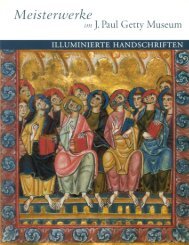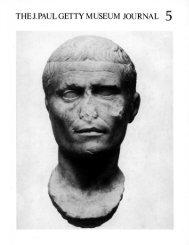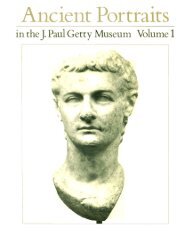The J. Paul Getty Museum Journal Volume 15 1987
The J. Paul Getty Museum Journal Volume 15 1987
The J. Paul Getty Museum Journal Volume 15 1987
You also want an ePaper? Increase the reach of your titles
YUMPU automatically turns print PDFs into web optimized ePapers that Google loves.
44 Cassidy-Geigerpicts Venus and Adonis with cupids after the renderingof the subject by Francesco Albani (<strong>15</strong>78—1660). 20<strong>The</strong>scene on the underside (fig. 4b) shows nymphs disarmingsleeping cupids on the order of Diana. Engravingsafter Albani by Benoit I. Audran (1661—1721) were identifiedas the source for the scenes on both sides of thedish by A. Brüning in 1905 (figs. 5a-b). 21Albani'spaintings, like Mignard's cycle, were popularized in setsof tapestries as well. 22That the mythological scenes were not recognized asallegorical subjects as well is made clear by the fact thatthe bowls that should have been paired with the dishesin the Du Sartel sale were instead paired together in lot<strong>15</strong>1: "Paire de bols de meme porcelaine et de memedecor primitif, bordures bleues et gravures dans la päteavant la mise en couverte; ils on ete egalement surdecoresde sujets mythologiques en noir rehausse d'or.Iis sonts garnis de montures ä pied en bois sculpte etdore les transformant en sortes de coupes." 23One of the Du Sartel bowls is probably that whichwas later in the List collection and was described byPazaurek as mounted on an old wooden base and decoratedon both sides with mythological scenes showingJupiter, Juno, and Amoretti. 24In the same paragraphPazaurek also mentions the dish in the museum at Sevresas well as a bowl from the von Parpart collection, whichwas acquired by the Nordböhmische Gewerbemuseumin Reichenberg (present-day Liberec) and was also decoratedon both sides with "dichten Landschaftsfriesenvon weiter Perspektive nebst figurenreicher Staffage(antikes Opferfest und Bacchanalien) in goldgehöhterSchwarzlotmalerei." 25<strong>The</strong> bowl is illustrated and describedin the 1912 von Parpart sale catalogue, 26and thesame description is repeated almost word for word inthe new acquisitions listing published in the Zeitschriftdes Nordhöhmischen Gewerbemuseums for 1912:3. Runde Kumme mit unterglasblauen Bordüren, aufsreichste überdekoriert in Schwarzlot, mit Goldgehöht. Landschaftsfries mit weiter Perspektive,Ortschaften, zwischen Bäumen versteckt, Feldern,Tempeln und Burgen. Auf der Aussenseite alsStaffage ein antikes Opferfest, auf der InnenseiteBacchanalien mit vielen Figuren. Das PorzellanChina XVII. Jahrh. die Malerei von einem deutschenUberdekorateur. Meissen, Anfang XVIII. Jahrh.Ohne Marke. Höhe 7.5 cm., Durchm. <strong>15</strong> cm. Erworbenauf der Auktion Parpart in Berlin. 27<strong>The</strong> bowl illustrated in the von Parpart sale catalogueappears to be the one now owned by the J. <strong>Paul</strong> <strong>Getty</strong><strong>Museum</strong> and was undoubtedly one of the pair of bowlssold from the Du Sartel collection. By the time of thevon Parpart sale, it had lost its wooden stand and exhibiteda crack. It is possible, however, that a secondbowl exists, for another example of a dish like thatin the Sevres museum was illustrated by Hofmanninl932. 28<strong>The</strong> decoration of the <strong>Getty</strong> bowl can be dated tocirca 17<strong>15</strong>—1720. As noted above, the type of porcelainused by Preisslerwould not have been available inEurope until after circa 1710 when it was first producedin China. <strong>The</strong> initial engraved series by de Poilly hasbeen dated to circa 1710, 29and the second series, presumablythe source for the <strong>Getty</strong> bowl and the Sevresdish, was already in use in Augsburg circa 1710—1712when Elias Adam executed a beaker enameled with thetriumph of Bacchus after Mignard. 30Müller-Hofstedehas pointed out the strong stylistic and thematic tiesbetween the Sevres dish and a large covered goblet inthe Umeleckopraumyslove Muzeum in Prague (UPM10017/1906). 31 <strong>The</strong> goblet is completely painted inSchwarzlotand gold with foliate strapwork and twomythological scenes from the ceiling of the Palazzo Farnese,painted by Annibale Carracci (d. 1609). <strong>The</strong>triumphof Bacchus and Ariadne, a version different fromthat by Mignard, is depicted as a frieze running aroundthe cup, and the procession of nereids, tritons, andcupids accompanying Peleus and <strong>The</strong>tis advancesaround the cover. <strong>The</strong> scenes were copied from one ofthe sets of engravings that illustrate the painted ceiling,probably that by Pietro Aquila (1650—1692). This seemsto be the only set from the period in which the scenesof Bacchus and Ariadne and Peleus and <strong>The</strong>tis are not20. <strong>The</strong> sale took place at the Hotel Drouot, Paris, June 4-9, 1894;see the catalogue: Catalogue des porcelaines et faiences europeennes et deVextreme-orient . . . formant la collection de feu M. O. Du Sartel . . . ,p. 30, lot <strong>15</strong>0. <strong>The</strong> width of the dishes is given as 21 cm. <strong>The</strong> onlyillustration of the top of the other dish is in an article published in1905, see infra, note 22.In the story of Diana and Endymion, Endymion endures eternalsleep in return for perpetual youth and so is generally depicted asleepwhen visited by Diana, his lover. For this reason, it is likely that thesubject of the decoration was misinterpreted at the time of the 1894sale. <strong>The</strong> figure standing with a spear and a dog does not representDiana, but rather Adonis, and the sleeping figure is intended tobe Venus.21. A. Brüning, "Kupferstiche als Vorbilder für Porzellan," Kunstund Kunsthandwerk 8 (1905), pp. 28-29.22. See Maurice Fenaille, Etat general des tapisseries de la manufacturedes Gobelins . . . (Paris, 1903), vol. 2, pp. 399-417, and H. C. Marillier,"<strong>The</strong> Venus and Adonis Tapestries after Albani," Burlington Magazine54 (1929), pp. 314-320, pis. I—III.23. Du Sartel sale catalogue (supra, note 20), pp. 30—31. <strong>The</strong>heights of the bowls are given as 13 cm, a measurement which obviouslyincludes the wooden mounts; the diameter of the bowls isgiven as 16 cm.24. Pazaurek (supra, note 3), p. 214.








